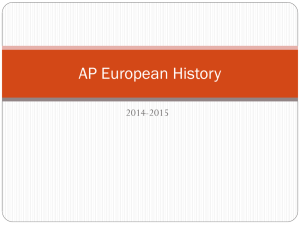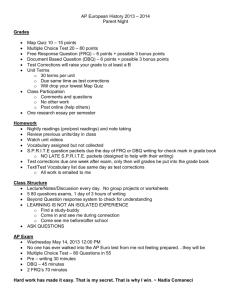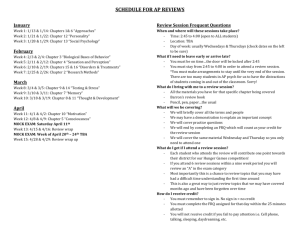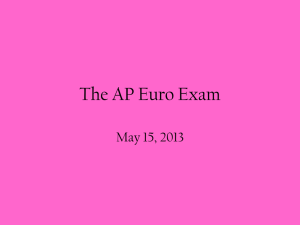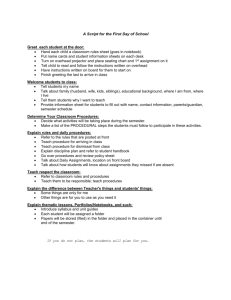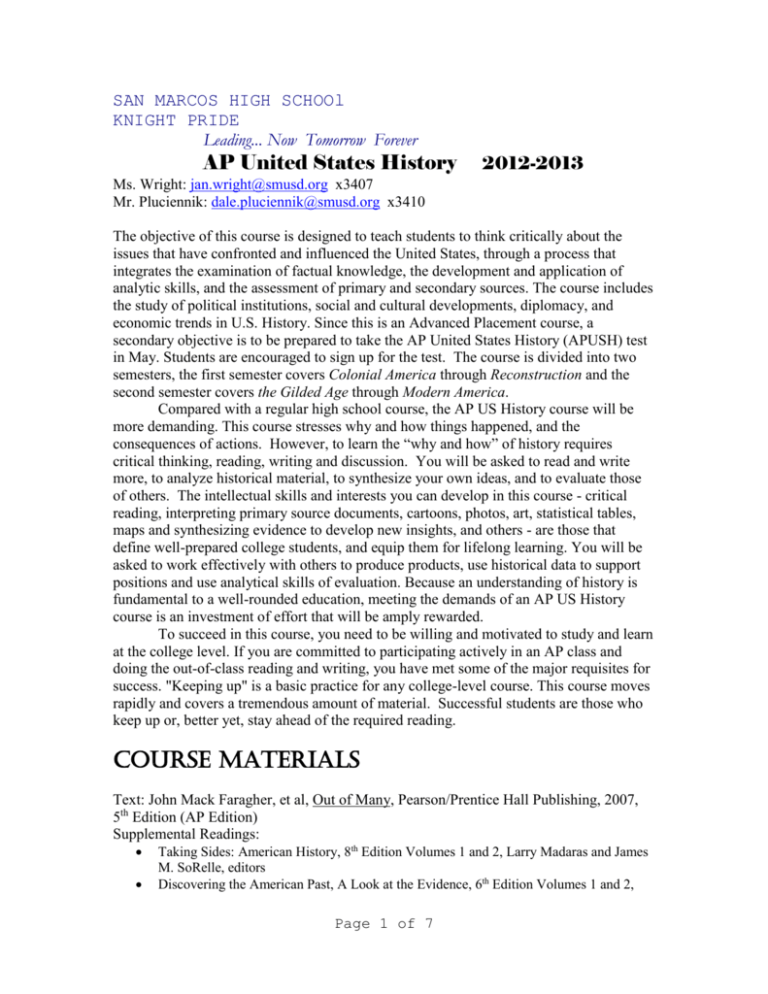
SAN MARCOS HIGH SCHOOl
KNIGHT PRIDE
Leading... Now Tomorrow Forever
AP United States History
2012-2013
Ms. Wright: jan.wright@smusd.org x3407
Mr. Pluciennik: dale.pluciennik@smusd.org x3410
The objective of this course is designed to teach students to think critically about the
issues that have confronted and influenced the United States, through a process that
integrates the examination of factual knowledge, the development and application of
analytic skills, and the assessment of primary and secondary sources. The course includes
the study of political institutions, social and cultural developments, diplomacy, and
economic trends in U.S. History. Since this is an Advanced Placement course, a
secondary objective is to be prepared to take the AP United States History (APUSH) test
in May. Students are encouraged to sign up for the test. The course is divided into two
semesters, the first semester covers Colonial America through Reconstruction and the
second semester covers the Gilded Age through Modern America.
Compared with a regular high school course, the AP US History course will be
more demanding. This course stresses why and how things happened, and the
consequences of actions. However, to learn the “why and how” of history requires
critical thinking, reading, writing and discussion. You will be asked to read and write
more, to analyze historical material, to synthesize your own ideas, and to evaluate those
of others. The intellectual skills and interests you can develop in this course - critical
reading, interpreting primary source documents, cartoons, photos, art, statistical tables,
maps and synthesizing evidence to develop new insights, and others - are those that
define well-prepared college students, and equip them for lifelong learning. You will be
asked to work effectively with others to produce products, use historical data to support
positions and use analytical skills of evaluation. Because an understanding of history is
fundamental to a well-rounded education, meeting the demands of an AP US History
course is an investment of effort that will be amply rewarded.
To succeed in this course, you need to be willing and motivated to study and learn
at the college level. If you are committed to participating actively in an AP class and
doing the out-of-class reading and writing, you have met some of the major requisites for
success. "Keeping up" is a basic practice for any college-level course. This course moves
rapidly and covers a tremendous amount of material. Successful students are those who
keep up or, better yet, stay ahead of the required reading.
Course Materials
Text: John Mack Faragher, et al, Out of Many, Pearson/Prentice Hall Publishing, 2007,
5th Edition (AP Edition)
Supplemental Readings:
Taking Sides: American History, 8th Edition Volumes 1 and 2, Larry Madaras and James
M. SoRelle, editors
Discovering the American Past, A Look at the Evidence, 6th Edition Volumes 1 and 2,
Page 1 of 7
William Bruce Wheeler and Susan D. Becker
Out of Many: Documents Workbook
Enduring Voices, Volumes 1 and 2, James J. Lorence
AP U.S. History Practice Exam Book (5th Edition), Thomas Barnes and Gordon Utz
Records from the National Archives – Teaching with Documents Series.
Major Themes of the Course:
The main themes that we will address are:
1. Identity, Diversity
5. America in the World
2. Work, Exchange, and Technology
6. Environment and Geography
3. Peopling, Demographics, Slavery
7. Ideas, Beliefs and Culture
4. Politics and Power
The course themes are designed to encourage students to think conceptually about the
American past and to focus on historical change over time. Class discussions,
assessments and assignments are interlaced with the themes of the course.
Course Outline - First Semester
Unit 1: Early America and Colonial America
Summer Assignment is Chapters 1-5, due on the first day of school, Aug. 20.
Review of chapters 3-5 (Aug. 20 – Sept. 7) - 3 weeks
Big Picture Statement:
By 1754, the Colonial Empires in North America had developed into complex and unique
social, political, economic and cultural regions that both interacted with each other as
well as the Native Americans.
Key Topics: the nature of Native American cultures in the three major regions of
European invasion and settlement; the collision of cultures between Native American
settlements and European colonies in the North America; comparison and contrast of
southern, middle and New England colonies; Native American warfare and conflict; the
early history of slavery and racism, the role of religion in colonial culture.
FRQ: Religious freedom in Colonial America
DBQ: Colonial Chesapeake and Colonial New England
Unit 2: Origins of the American Republic (Revolutionary era, Early Republic)
Chapters 6 – 8 (Sept. 10 – Sept. 28) 3 weeks
Big Picture Statement: Great Britain’s changing policies toward the colonies leads to
the American Revolution and in the aftermath, a new republic is formed.
Key Discussion Topics: the origins of resistance and the rise of American nationalism;
changing British political policy toward the colonies; the military course of the war and
the pending political changes; the establishment of the first national government and
political parties.
FRQ: The Effectiveness of the Articles of Confederation
DBQ: The Revolutionary Era as a time of social, political and economic change
Page 2 of 7
Unit 3: Antebellum America (expansion, growth and pre-Civil war)
Chapters 9 – 13 (Oct. 1 – Nov. 2) 5 weeks
Big Picture Statement: By 1850, America was fractured by sectionalism, westward
expansion, slavery, and the ongoing struggle with states’ powers.
Key Discussion Topics: the early development of America’s economy and the forging of
a national identity, the economic implications of “King Cotton” and the changing social
structure of the South and the rise of abolitionism; the creation of a distinctive American
cultural identity and the establishment of the basic two party pattern of American
political democracy; the effects of industrialization and the emergence of the middle
class; the arise of social problems that accompanied urbanization and immigration and
the responses of reformers.
FRQ: The Emergence of the two-party system
DBQ: Reform and the Expansion of Democratic ideals
Unit 4: Westward Expansion, Civil War and Reconstruction
Chapters 14 – 17 (Nov. 5- Dec. 7) 4 weeks
Review for Final Dec. 10-14
Big Picture Statement: The Civil War is a turning point event that transforms America
into a country with a stronger federal government yet not forgetting the ongoing quest for
civil rights.
Key Discussion Topics: the political effects of continental expansion and its heightened
sectional tensions; the rise of the Republican Party and the secession of the Southern
states; the social and political changes created by the Civil War; the legacy of
Reconstruction, and post-Civil War transformations in the economic and political life of
the North.
FRQ: The effectiveness of political compromise in reducing sectional tensions in the
period, 1820 to 1861.
DBQ: How revolutionary was the Civil War and Reconstruction era?
SECOND SEMESTER
Unit 5: The Gilded Age
Chapters 18 – 20 (Jan 14 – Feb. 1) 3 weeks
Big Picture Statement: The closing of the frontier opened the door for globalization,
industrialization, massive immigration, imperialism and the need for reform, once again.
Key Discussion Topics: the impact of western expansion on Native American societies;
the growth of cities and the rise of big business and the organized labor movement; the
Gilded Age, the rise of the New South, the economic and political crisis in the 1890s; the
rise of the U.S. as a world power.
FRQ: How and why did transportation developments spark economic growth during the
period from 1860 to 1900 in the U.S.?
FRQ: How was overseas imperialism in 1898 similar to and different from earlier
American continental expansion?
DBQ: Labor Unions of the late 19th century
Page 3 of 7
Unit 6: The Rise of the American Century
Chapters 21 – 25 (Feb. 4 – Mar. 8) 5 weeks
Big Picture Statement: The first half of the twentieth century is a roller coaster ride with
WWI, the roaring twenties, the stock market crash and Great Depression and back into
war again with WWII.
Key Discussion Topics: the political, social, and intellectual roots of progressive reform;
from neutrality to participation in the Great War; the Roaring Twenties, causes and
consequences of the Great Depression, the legacies and limits of New Deal reform;
World War II with an emphasis on the home front.
FRQ: How did some of the events of the 1920s reflect national conflicts over social,
cultural, and religious values?
DBQ: The effectiveness of Progressive Era reformers
DBQ: The effectiveness of the New Deal
Unit 7: Cold War and Modern America
Chapters 26 – 31 (Mar. 11- Apr. 19) - 5 weeks
Big Picture Statement: The beginning of the Cold War moves America into the atomic
age that will never go away as Americans are faced with internal and external strife.
Key Discussion Topics: the Cold War culture and society, diplomatic policy during the
Cold War; 1950s prosperity, the Civil Rights movement for all people, Vietnam, sixties
generation, Nixon and Watergate, rise of the conservatives, the eighties and beyond.
FRQ: 1950s conformity
DBQ: Analyze the ways in which the Vietnam War heightened social, political, and
economic tensions in the United States.
Unit 8: A.P. U.S. History Exam Review.
Spring Break – March 25 to Mar. 29.
Class review will be from April 22 to May 8.
AP US History exam is Friday, May 10.
After the AP exam, students will work on a project that will also be the semester final.
Academic Responsibility
Each of you is responsible for your academic performance. It is up to you to
arrange to make up tests, to get any assignments that you have missed, and to turn them
in on time. If you have questions, it is your responsibility to ask them. I also expect you
to be honest about your own work. When you turn in an assignment, it must be your own
work, not the work of someone else. To turn in the work of someone else as your own is
indecorous in academics.
Assignments and Grading Policy
In most units, you will write a minimum of one Free-Response Essay (FRE)
and/or one Document Based Question (DBQ).
Starting with Unit 2, you will do a one-pager that includes big picture statements,
quotes, visuals, and change over time, themes, comparisons, relationships and
more.
Page 4 of 7
In every unit, you will be asked to interpret a wide variety of primary sources,
such as documentary materials, maps, cartoons, charts and tables and pictures.
Unit tests will be given at the conclusion of a unit. You have one week to make
up any test that you miss. Failure to make up a test will result in a zero for that
test. All test make-ups are to be done outside of class time.
Assignments are due at the beginning of class. Late work is accepted for 60% of the
points. No late work is accepted after one week.
It is your responsibility to get any work missed because of an excused absence. As a
reminder, you may not make-up any work missed because of an unexcused
absence or truancy. Lockout is never an excused absence.
In order to do well in this class, you must not only do the work, but you must score
well on the tests and quizzes. The grading scale is as follows:
Grade
A+
A
AB+
B
BC+
C
CD+
D
DF
Percentage
98%
92%
90%
88%
82%
80%
78%
72%
70%
68%
62%
60%
Less then
60%
Grades are weighted as follows:
Homework – 25%
In-class work – 25%
Tests – 15%
Chapter quizzes – 20%
Essays, writing assignments - 15%
ESLRs (Expected School wide Learning Results)
Effective Communicators
Effective Problem Solvers
Effective Citizens
Materials
3-Ring Binder
Each student should maintain a separate AP US History Binder. It
should be a large (at least 1.5”) three-ring binder with dividers. Your
binder needs to be organized in the following manner
Reading List, Syllabus, etc.
Class notes, dated
Reading Notes
Tests and Quizzes
Essays
Handouts
Class Work
A separate notebook may be required for the second semester
due to the heavy volume of paper work. This notebook will
help you study for your final and for the AP Exam. You are
expected to keep all of your work.
Page 5 of 7
Pen
All essay assignments are to be done in blue or black ink pen.
All assignments including chapter work completed at home
must be handwritten. No typed papers will be accepted.
I also suggest that you get a copy of an APUSH review book during the first
semester. There are many books to choose from and they are not required, they
are only recommended.
Class Rules
I have a few basic rules for this class, and they are . . .
Do not talk while I am talking, or while a student is presenting.
Unauthorized classroom use of electronic devices is subject to the behavior code.
No eating, drinking, wearing of hats or hoods in class.
Be seated and ready to go when the final bell rings. Unless instructed
otherwise, remain seated until the dismissal bell rings.
Always come to class prepared.
On all assignments, if you do not have your name you will
lose one point.
Attendance Policy
Students are expected to attend school daily, and be on time for class. If a student is
absent from class without a valid excuse or leaves class without the teacher’s permission,
he/she is considered truant.
In accordance with State Education Code requirements, a student must be in class a
minimum of 60 hours to receive five units of credit. Students may be dropped from class
for excessive absences, if the teacher determines that the absences in combination with
lack of effort, lack of academic success, or poor attitude results in disruptive behavior.
Any student missing more than 30 days of any one class in a semester, will not receive
credit for that class. Students may not concurrently take a course that they are enrolled in
at the high school. Additionally, a course may only be remediated once the term has been
completed. Seniors only may remediate a second semester course during the summer,
which may impact participation in the graduation ceremony and / or receipt of diploma.
1.
2.
3.
Discipline Policy
First classroom disruption = verbal warning, call home to parent.
Second classroom disruption = referral to Assistant Principal’s office and In
School Suspension assigned.
Third classroom disruption = referral to Assistant Principal’s office and removal
from class.
Page 6 of 7
Detach and Return
-------------------------------------------------------------I have read and understand the requirements and policies of the San Marcos High School
AP U.S. History class.
Parent Signature:________________________________________________________
Contact Phone Number:
Home ___________________________Cell ___________________
E mail: ______________________________________________
Student Signature:
I have read and understand the requirements and policies of the San Marcos High School
AP U.S. History class and AGREE to these requirements and policies.
Student Name (printed):____________________________________ Period _________
Student Signature: ________________________________________________________
Knight Pride
"Leading, Now, Tomorrow, Forever"
Page 7 of 7

